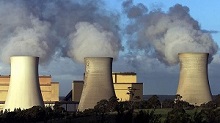It hasn’t happened yet, not officially. The final decision rests with an august scientific body called the International Commission on Stratigraphy, which has a 36-person Working Group on the Anthropocene. Now 24 scientists, including some from the Working Group, have produced a paper advocating for the Anthropocene to be recognised as having begun in the mid-20th century.
The classification goes like this. The Cenozoic Era began 65 million years ago.
- The Cenozoic is divided into three periods: The Paleogene, Neogene, and Quaternary; and seven epochs: The Paleocene, Eocene, Oligocene, Miocene, Pliocene, Pleistocene, and Holocene.
Now being considered is whether the Holocene epoch should give way to the Anthropocene. There are reports at Climate Progress and the SMH.
In the mid-20th century a lot of things happened, including nuclear explosions, a burst of building fossil-fuelled power plants, the widespread use of plastics and covering the planet with cement.
Carbon dioxide emissions are rising 100 times quicker than at any time during the past 800,000 years.
Mining displaces 57 billion tonnes of material a year, or almost three times the amount of sediment carried by the world’s rivers.
Enough plastic is produced each year to wrap the planet, and enough aluminium to cover Australia.
- Half of the concrete produced has been poured in the past 20 years alone, as impacts accelerate, the paper said. Historically, production is in the order of 50 billion tonnes, or enough to cover every square metre with a kilogram of concrete.
As this article says, the clearest fingerprint humans have left, in geological terms, is the presence of isotopes from nuclear weapons testing that took place in the 1950s and 60s.
What it comes down to, though, is whether the change in nomenclature is scientifically justified, or are scientists getting caught up in a communications strategy?
The working group hopes to present a proposal to the International Commission on Stratigraphy later this year. Approval would convey to the wider world the scale of what humanity is doing to Earth. For many geologists, however, a longer perspective is needed. To them half a century is not even yesterday.
Phil Gibbard, a geologist at the University of Cambridge who initially set up the working group:
- suggested it might be better if the Anthropocene was seen as a cultural term – such as as the Neolithic era, the end of the stone age – rather than a geological one.
Here’s an impressive image of a human-made environment, a concrete jungle in Hong Kong:

Whether the geologists are impressed or not, we are certainly making an impact.


We don’t declare a new era for every penny band in a coal seam so I think we are a bit premature about the Anthropocene. If all the doom and gloom about the future of humanity turns out to be true the signs we are talking about here will be nothing more than an interesting blip ob the geological record.
John, I suspect in geological terms they lost the plot when they declared the Holocene an epoch. After all it’s only an interglacial and we’ve had plenty of those which went unremarked.